Movies
Click on the thumbnail images below to learn more about the hearing devices and to see the Object VR movies. |
Click here to download QuickTime Player (free) |
|
|
|
|
|
| VC703017 |
VC703028 |
VC703029 |
VC703033 |
VC703040 |
|
|
|
|
|
| VC703050 |
VC703095 |
VC703096 |
VC703098 |
VC703100 |
|
|
|
|
|
| VC703101 |
VC703102 |
VC703110 |
VC703126 |
VC703129 |
|
|
|
|
|
| VC703137 |
VC703313 |
VC703334 |
VC703358 |
VC703379 |
 |
Bilateral Circular Receptor
This black lacquered bilateral circular receptor trumpet hearing device was manufactured by Thomas Hawksley, Ltd. of London and dates from the 19th century. Two circular receptors are arranged back to back at the end of a single fixed tube. The receptor pans (5-1/4 inches in diameter) are partially covered, forming two hollow convex receptors open in opposite directions. The earpiece is curved and made from vulcanite. The hearing device could be hung around the user’s neck with a cord running through a small ring on the tube section. The overall length is 16-1/2 inches. |
Back to Thumbnails |
Click here for 800 x 500 file
Click here for 560 x 360 file |
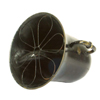 |
London Dome Hearing Trumpet
This black enameled brass London dome trumpet was manufactured about 1850 by F.C. Rein & Sons in London. This style of ear trumpet was popular in the late 18th and early 19th centuries. The trumpet has a bell-shaped sound collector and its name is derived from its resemblance to a London church dome. The sound receptor has a flowered scroll design and is 8-1/4 inches wide. A curved tube along the side of the dome opens in the apex of the resonating dome and leads to an opening for the ear. A curved handle on the opposite side of the dome allows the device to be held to the ear with the opening toward the speaker. The device, which is about 9-1/2 inches high, weighs approximately 2 pounds. |
Back to Thumbnails |
Click here for 800 x 590 file
Click here for 560 x 420 file |
 |
London Dome Hearing Trumpet
This device is a variation of the London Dome ear trumpet. Made of black-enameled brass, it is about 19-1/2 inches long with a 5 inch wide sound receptor. The receptor opening is covered with a grill, called a “refiner,” meant to soften the sound. The curved earpiece is made of ivory. The tube and earpiece section (14 inches long) can be detached from the sound receptor. There is a small ring at the base of the tube to allow a user to wear the device around the neck with a cord. Date and manufacturer are unknown. |
Back to Thumbnails |
Click here for 800 x 380 file
Click here for 560 x 260 file |
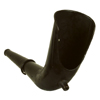 |
Tragus-like Ear Trumpet
This black metal tragus-type hearing device has a curved metal sound receptor with a 2 inch wide opening. The 3 inch long earpiece section is removable from the curved sound receptor. There are 14 small holes punched in the device. On the base of the funnel is a threaded bracket that may fit into another apparatus. “REINER WIEN” is inscribed on the base of the funnel. |
Back to Thumbnails |
Click here for 800 x 480 file
Click here for 560 x 300 file |
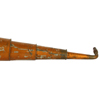 |
Telescoping Ear Trumpet
This lacquered copper ear trumpet may be the collapsible version of the Townsend Trumpet, popular in England in the late 18th and early 19th centuries. The three sections and earpiece collapse into each other – allowing users to store the device in a pocket or purse when not in use. The expanded length is almost 14 inches; the collapsed length is just 5 inches. The sound receptor section has a 2-5/8 inch wide opening. The curved earpiece has a vulcanite tip. Date and manufacturer are unknown. Thomas Hawksley sold similar telescopic devices, called Telescopic Cones, and advertised them as being “very strong, powerful and durable.” |
Back to Thumbnails |
Click here for 800 x 350 file
Click here for 560 x 230 file |
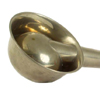 |
Double Parabolic Ear Trumpet
This nickel-plated double parabolic trumpet is collapsible, expanding to 11-1/2 inches when fully opened. The double convex design features two opposing parabolic balls with a long earpiece extending from the smaller ball. The larger ball is 3-1/2 inches wide. The curved earpiece has an ivory or bakelite ear tip; it also has a small ring soldered to it, allowing the device to be worn around the neck with a cord. Date and manufacturer are unknown. |
Back to Thumbnails |
Click here for 800 x 440 file
Click here for 560 x 320 file |
 |
Small Ear Trumpet
This small bugle-shaped ear trumpet was manufactured by T. Hawksley of London and dates from the late 1800s. The overall length is about 7-1/2 inches; the sound receptor is about 3 inches wide. Hawksley advertised these devices as trumpets where “. . . the cone is doubled or folded upon itself after the manner of a bugle, so that in use it may be partially concealed by the hand. They are powerful, durable and very portable, and meet the requirements of a considerable range of deafness.” |
Back to Thumbnails |
Click here for 800 x 560 file
Click here for 560 x 380 file |
 |
Miniature Ear Trumpet
This miniature black and gold enameled metal ear trumpet dates from the 19th century and was made in either France or England. It is designed to be positioned over and behind the outer ear. A tiny knob on the black receptor section allows for the earpiece to be turned so that the device can be worn on either ear. The elongated receptor opening is 1-1/4 x 2-3/4 inches wide. This type of miniature trumpet was lightweight and provided some assistance for the slightly hearing impaired. Manufacturer is unknown. |
Back to Thumbnails |
Click here for 800 x 550 file
Click here for 560 x 380 file |
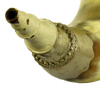 |
Small Ear Trumpet
This elegant ram’s horn dates from about 1800. It was given to Max A. Goldstein, founder of Central Institute for the Deaf, by Thomas Hawksley of Hawksley, Ltd. in London. The horn is 10-1/2 inches long with silver trimming and an ivory earpiece. The wide open end measures approximately 2-3/8 x 2-7/8 inches. “HAWKSLEY, LONDON” is noted on a small plaque on the base of the rim. This type of device was popular during the 18th and 19th centuries. Descriptions of the use of natural horns as hearing devices date back as early as the 16th century. |
Back to Thumbnails |
Click here for 800 x 440 file
Click here for 560 x 310 file |
 |
Artificial Concha
This beautiful artificial concha, from London’s F. C. Rein and Son, about 1830, is made of gold-plated silver. Custom-designed and molded for each user, the concha would have been worn as a self-retaining adornment that could blend in with a hairstyle or jewelry. The 2-3/8 by 3/4 inch opening is covered by a decorative filigree grill. The outer face of the device is a carved shell shape. The earpiece fits entirely in the pinna of the ear and allows the user to wear the device without any visible means of support. Though small and lightweight (only 0.8 ounces), the concha provides up to a 13 dB gain for frequencies around 1.5 kHz and would benefit a person with a mild hearing loss. |
Back to Thumbnails |
Click here for 800 x 650 file
Click here for 560 x 480 file |
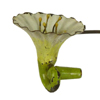 |
Aurolese Phones
This floral Aurolese Phone was made by F. C. Rein and Son about 1802. Though over 200 years old, this device still shows its original white and green paint. The device weighs only 1.4 ounces and its aperture measures 2 inches wide. Despite its fragile appearance and size, the Aurolese Phone provided an acoustic benefit up to 10 dB over a limited frequency range, 1.5-2.0 kHz, and was appropriate for a person with a mild hearing loss. |
Back to Thumbnails |
Click here for 800 x 560 file
Click here for 560 x 400 file |
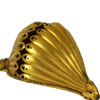 |
Bouquet Holder
This dome shaped, gold-plated metal bouquet holder hearing device was manufactured about 1880 by Thomas Hawksley, Ltd. The Hawksley catalog described this aid as a “pretty device for assisting the best ear, in not very severe cases of deafness.” The aid was attached to the breast of a lady’s dress, with an elastic tube and curved vulcanite earpiece leading to the ear. Delicate gold leaves form the 2-3/4 inches high dome shape, which could be used to hold a few flowers, or be concealed by lace or other trimming. There are two hooks on the back which could be used to hang the device from clothing. Though disguised, this bouquet device seems too large (8-1/4 by 3-3/4 inches by 2-3/4 inches) and heavy (7.6 ounces) to be worn comfortably. |
Back to Thumbnails |
Click here for 800 x 470 file
Click here for 560 x 330 file |
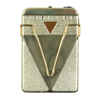 |
Toshiba Model THA-1001
Toshiba introduced the THA-1001, a 4-transistor hearing aid, in 1961. This silver case over black plastic chassis model was small in size (1-7/8 inches wide by 2-7/8 inches long) and came with 2 batteries, a standard earphone, and a super-sensitive Danish earphone. The triangular shaped microphone on the front was advertised as “ultra-sensitive.” The THA-1001 also came with three rubber tips of different sizes to be placed on the receiver for insertion into the ear canal. The device was marketed by Radio Shack with a list price of $34.95. |
Back to Thumbnails |
Click here for 700 x 650 file
Click here for 490 x 480 file |
 |
Paravox Model D
The Paravox Model D “Top-twin-tone” vacuum tube model hearing aid was one of the smallest aids on the market in 1950, measuring 3 inches long by 1-3/4 inches wide. The aid contains 3 vacuum tubes, 2 crystal microphones, and one on/off and volume control switch. The microphones were placed on the top of the aid in order to avoid annoying “clothing microphone scrape.” The brushed silver and gold case has a filigreed opening on the front and a gold clip on the reverse side. This model was one of the last Paravox vacuum tube models manufactured. |
Back to Thumbnails |
Click here for 550 x 630 file
Click here for 410 x 480 file |
 |
Beltone Triumph 6 Super
Beltone Electronics of Chicago, Illinois introduced the Triumph 6 Super model hearing aid in 1961. This 6-transistor aid has a stainless steel body with a black casing and is meant to be worn in a pocket or on a tie as a tie clip. The gold clip on the front holds the decorative microphone. The on/off switch is on the back of the device; the loudness and volume control switches are on either side. The aid measures 3/4 inches wide by 3-1/2 inches long. |
Back to Thumbnails |
Click here for 550 x 630 file
Click here for 410 x 480 file |
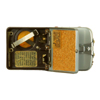 |
Acousticon A-130
Acousticon Electronics introduced the A-130 (Constellation), a one-piece vacuum tube hearing aid, in 1948. The stainless steel case, measuring 2-3/8 x 4-3/4 inches, has the tone control switch on the side and the volume control dial at the top. The microphone on the front is covered by a small red grill. This model was available with a head band and bone conduction receiver or the more common air conduction earpiece. |
Back to Thumbnails |
Click here for 800 x 460 file
Click here for 560 x 330 file |
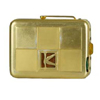 |
Otarion Model G2 Whisperwate
The Otarion Model G2 “Whisperwate,” a 1-piece, 3-vacuum tube model, dates from about 1951. The device has a gold metal front and black plastic back; the microphone grill on the front features a flying bird design. There are clips on both sides. On the top are a green dial and a plug for the ear cord. The battery case swings open from the bottom of the back. The “Whisperwate” measures just 1-7/8 inches wide by 2-1/2 inches long. |
Back to Thumbnails |
Click here for 460 x 330 file
|
 |
Zenith Model 75
Zenith introduced the Model 75, a 3-piece vacuum tube body aid device, in 1947. The plastic case was partially clear and measured 2-3/4 inches wide by 5-1/4 inches long. A gold semi-circular design disguised the microphone grill on the front. The Zenith 75 was deliverable by mail and required no fitting. The list price was $75.00, a low price that Zenith advertisements emphasized. Most Zenith advertisements included a signed statement by the company’s president that stated, “If we wanted to build a hearing aid to sell at $150 or $200 we would not know how to manufacture Zenith instruments better – or how to obtain more efficient materials than now go into our $75 hearing aids.” |
Back to Thumbnails |
Click here for 550 x 630 file
Click here for 410 x 480 file |
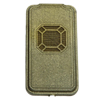 |
Western Electric Model 38-A
Western Electric introduced this Model 38-A in 1932. This 2-piece carbon aid has an octagonal microphone insert on the front and a silver clip on the back. The body is made of polished metal, green-gray in color, 3 inches wide and 5-5/8 inches long, with plugs leading to the earpiece and to the battery pack. |
Back to Thumbnails |
Click here for 800 x 540 file
Click here for 560 x 380 file |
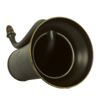 |
Dome Trumpet
This device dates from the mid 1800s and is a black hat dome trumpet model. The receiver protrudes from the main body and is flat on top. It is 5-1/2 inches long with an aperture opening of three inches. The manufacturer is unknown. Thomas Hawksley sold similar devices as Resonators and were available in a variety of finishes such as scroll engraving, repoussé, and gilded. |
Back to Thumbnails |
Click here for 800 x 440 file
Click here for 560 x 320 file |
|
